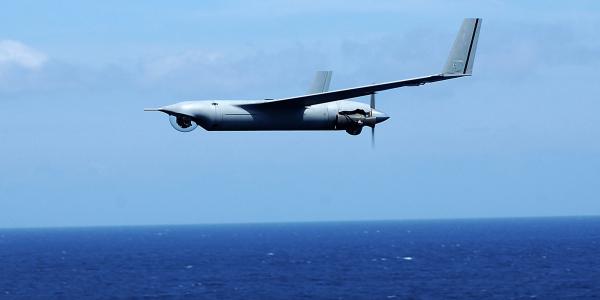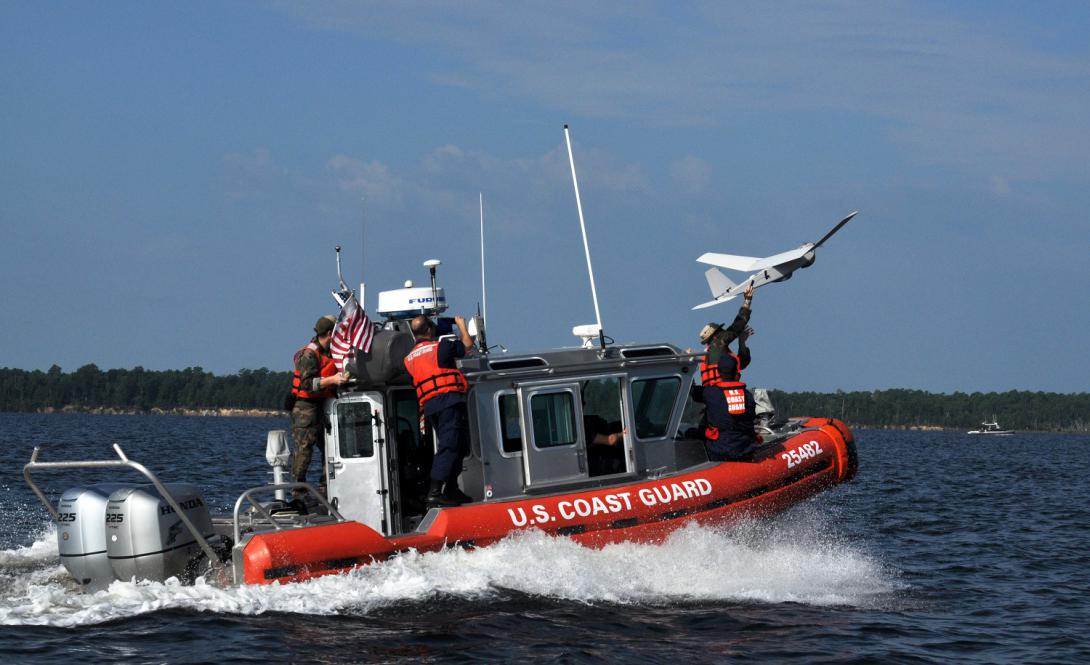High Hopes for Unmanned Aircraft On the High Seas
The U.S. Coast Guard needs more unmanned aircraft as eyes in the sky to support key missions such as search and rescue, drug interdiction and maritime patrol. The service will soon deploy these aircraft from its cutters as part of a long-term effort to expand the Coast Guard’s use of airborne robot platforms. Both ships and shore-based installations will be equipped with medium-range unmanned aerial systems to aid manned aircraft and provide real-time, around-the-clock surveillance.
Acquiring a variety of unmanned aerial systems (UASs) has been one of the Coast Guard’s goals for many years. But tight budgets meant that the service either had to operate as part of joint military programs or bide its time until funds became available. Some of that money came in recent years as Congress allocated funds for the Coast Guard to acquire a medium-range UAS (MRUAS) platform, explains Cmdr. Daniel Broadhurst, USCG, UAS Division chief with the Coast Guard’s Office of Aviation Forces.
The Coast Guard has three categories of UAS assets: long-, medium- and short-range platforms. Long-range UASs are large, land-based aircraft, such as the General Atomics MQ-9 Reaper, capable of flying up to 24 hours at altitudes over 18,000 feet. These aircraft are equipped with maritime surveillance radars and electro-optical and infrared sensors to monitor wide swaths of ocean. Because of their long-range surveillance roles, the platforms are not suitable for most search and rescue missions. “It’s a strategic asset,” the commander points out. “It’s not intended to be a tactical response unit for people in the water or on the ground, but it builds a big maritime domain and awareness picture.”
The Coast Guard’s long-range UAS operations are a joint effort with the Defense Department and the Department of Homeland Security (DHS). The Coast Guard supplies pilots and sensor operators to support the Customs and Border Protection’s MQ-9 Guardian operations over the Gulf of Mexico and Florida coastal waters. Since 2008, the service has provided eight pilots and 10 sensor operators to augment flight time and operating skills, Cmdr. Broadhurst says. The Coast Guard’s primary contribution is people rather than money or infrastructure. Participation provides valuable experience needed when the service is ready to stand up its own long-range UAS program, the commander maintains.
The MRUAS is a higher priority. MRUASs can be launched and recovered at sea or on land. They are tactical platforms with a 100- to 150-mile range, filling the same search and surveillance roles as the service’s medium- and short-endurance helicopters, Cmdr. Broadhurst says. Although MRUASs may not be complete intelligence, surveillance and reconnaissance solutions, they do provide essential situational awareness for individual cutters while freeing up manned platforms for other missions, he explains.
The MRUAS aircraft will operate from the Coast Guard’s National Security Cutters, which always were intended to carry unmanned aircraft when they set sail as part of the Deepwater program. The Coast Guard recently finished sea trials with a ScanEagle UAS operating from the cutter Stratton. But that aircraft is only a prototype to test operational viability, and the Coast Guard has not yet settled on a platform to fill its MRUAS needs, Cmdr. Broadhurst notes.
The MRUAS originated in 2012, when the DHS, the Coast Guard’s parent department, directed the service to look at commercial and government options for a midrange UAS. In 2012 and 2013, initial proof-of-concept trials were held. This led to an infusion of funding in 2015 and last year, culminating in the operational test. The first trial deployment aboard the Stratton, from January through April, was successful. Operating as a situational awareness tool for the cutter, Boeing’s ScanEagle was key to intercepting four high-speed drug-smuggling boats and seizing 5,000 pounds of illegal narcotics, Cmdr. Broadhurst says.
The test also changed how the Coast Guard operates its combat information centers (CICs). Traditionally, radio provides all operational information, but now UASs provide the Stratton’s CIC with full-motion video of an operation in progress. Deploying more UASs across the Coast Guard’s cutters will add this important command and control capability, the commander notes.
Although ScanEagle won the first contract for the prototype MRUAS deployment, it may not be the final choice for a servicewide platform when the contract is finally awarded in 2018, Cmdr. Broadhurst says. Operationally, the Coast Guard wants an MRUAS with a minimum flight endurance of 12 hours, allowing it to patrol and loiter at an ideal range of 20 to 100 miles from the cutter while remaining within the ship’s radar envelope. The aircraft will have a day-night capability, with electro-optical and infrared sensors and shipborne launch and recovery. The long-term goal is to acquire a platform that can take off and land vertically, allowing for operations from ships, air stations and deployed special forces units. “These capabilities are tremendous,” the commander states. “Anywhere you can put a helicopter now, we envision you can put an MRUAS in the future, and we intend to move in that direction.”
With the trial over, the service plans to release a request for proposals in the fourth quarter of this year, with an award tentatively scheduled for the third quarter of next year.
The MRUAS program fills a hole left by the Bell Eagle Eye tiltrotor UAS developed under the Deepwater program. The advanced vehicle, ahead of its time, was canceled because of high development costs, Cmdr. Broadhurst relates. The Coast Guard considered other UAS types as an interim solution, but those also had problems, he notes. Take the Navy’s MQ-8 Fire Scout robot helicopter. It requires a large crew for operation and support—roughly 20 to 30 people—but space for it is unavailable on a National Security Cutter.
The Coast Guard also is looking at hand-launched, short-range UAS (SRUAS) platforms. The commander cautions that the service has not yet defined its requirements for these platforms and that no acquisition funding exists for an SRUAS program. However, initiating a program is an important goal for the Coast Guard, he offers.
Because setting up operational wings for both long- and medium-range UASs is costly and calls for manpower and infrastructure, it could take more than a decade for SRUASs to become commonplace on Coast Guard ships, Cmdr. Broadhurst says. Still, SRUASs offer many benefits to the Coast Guard. In addition to their low cost and responsiveness, SRUASs can be operated by nonpilots, which is important because of the limited number of pilots available for other platforms, he points out.
Meanwhile, the Coast Guard is testing a variety of commercially available UAS types for use aboard its cutters, the commander says. The service also has partnered with both the Navy and the National Oceanic and Atmospheric Administration to test and operate small UASs aboard their vessels in the Arctic. Much like the MQ-9 program, this helps the Coast Guard gain experience in operating these platforms, he notes.
Some hurdles remain for the Coast Guard’s UAS program. For long-range platforms, a number of operational considerations loom. The first is obtaining necessary Federal Aviation Administration authorization to operate UASs in civilian airspace on short notice. “Search and rescue is reactive by nature. We don’t know where they’re going to be; we don’t know when they’re going to need us,” Cmdr. Broadhurst allows.
Another challenge is weather. Almost all unmanned aircraft have difficulty flying in poor weather conditions, he explains. “It’s an industrywide problem, but UASs aren’t good in the weather, and people rarely get into distress on nice, crystal-clear, beautiful days,” the commander observes. The Coast Guard needs unmanned aircraft that can operate at high latitudes, such as polar regions, and in heavy rain or icy, snowy conditions. Until they are weatherproof, long- and medium-range UAS platforms will not realize their full potential, Cmdr. Broadhurst says.






Comments